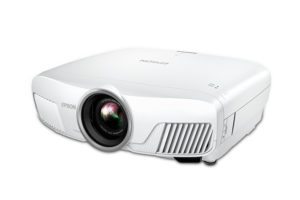EPSON HOME CINEMA 4000 4K CONTENT CAPABLE PROJECTOR SUMMARY: General Comments, Picture Quality, The Competition, Bottom Line and Value Proposition, Pros and Cons
The value of the Epson Home Cinema 400 is first and foremost, being one of the least expensive projectors at this time that can "play nicely" with real 4K content from sources such as a 4K Blu-ray UHD player. I'm not talking about using with some low cost, upscaling 1080 resolution Blu-ray player that can take 1080 content and upscale to 4K, but lacks the other goodies, such as HDR and wider color space found only with 4K content.. I'm talking about when reading a 4K disc, processing, and playing it. More on the specific competition below.

Epson's Home Cinema 4000 - A feature laden, 4K content capable projector for a rock bottom list price of $2199
The Epson uses a lot of "advanced processing" to make this happen. After all, true 4K is 8 million pixels (aka 8 megapixels). By comparison the HC4000 and other 1080p projectors with pixel shifting, are working with individual pixels 4x the area (twice the diameter) of true 4K pixels on a true 4K projector. Thanks to pixel shifting, though, the Epson outputs 4 million pieces of information, not the basic 2 million of straight 1080p.

This is our top regular award for projectors. In addition we offer additional awards in our special reports
Fancy processing creates some artifacts. Some of what appears as impressive sharpness and detail, is nothing more than "noise." But, remember, at the end of the conversation, it's your perception, which is why I like to use terms like "perceived sharpness and detail."
Personally, I'm no longer the "purist" I once was, when I would pooh-pooh fancy processing. At this point, I can appreciate that all that processing, despite adding some hardness to the image (noise) if you push it hard, definitely gives the impression of a sharper, more detailed image. And that's a noble goal, if not as good as having true extra sharpness and detail.
So, I really like these "pixel shifters" capable of working with 4K content, whether they come from Epson, JVC, and now, a host of DLP projectors using pixel shifting and DLP's new 4 megapixel chip. (Native 4 megapixel - double 1080p pixel shifters, but still half of true 4K.)

Image (uncalibrated) from Victoria Secret's Swim Suit special, in Bright Cinema mode
Of the new 4K UHD DLP projectors, the least expensive announced so far is $200 less at $1999. That would be the Optoma UHD60, the home entertainment version of the $2499 Home Theater UHD65 projector we reviewed last month. More below.
Epson rates the Home Cinema 4000 at 2200 lumens at full power in its brightest mode. Whoa! We measured over 2900 lumens, making it as bright as the 2500 lumen claimed HC5040UB, which measured similarly.
For those interested in the virtually identical Pro Cinema 4040 - $2499, but comes with a spare lamp, mount and cable cover, and a black case, we didn't do full measurements on that projector but figure they should measure almost identically to the HC4000!
For those of you who skip the middle pages of this review, the HC4000 is the full package when it comes to handling 4K content. I say that because it not only works with the 4K, but it supports HDR and BT.2020 the larger, more impressive color space used in movie theaters.
But it may be the full feature set that makes the HC4000 the value it is. Lens Memory is an important feature for those of us wanting to go "widescreen" for movie viewing. It has picture in picture, lots of fancy image processing, including detail enhancement, as well as CFI for smooth motion.
The projector sports and performs really well with 3D. It is about as feature laden as you will find. Oh, there are brighter projectors, and ones with better black levels, but finding a superior performing projector overall, with a large feature set, around the Home Cinema 4000 projector's price point is likely to prove frustrating at this time.
The HC4000 is a bit noisy at full power, claiming -32 db. Most of us can live with that, but the projector is a whole lot quieter in the other two power level modes.
I like the Epson remote, it's the same as for the Home Cinema 4000's siblings and give or take a button or two, like the remotes provided for a great many Epson projector models.
EPSON HOME CINEMA 4000 4K CONTENT CAPABLE PROJECTOR SUMMARY: General Comments, Picture Quality, The Competition, Bottom Line and Value Proposition, Pros and Cons
The value of the Epson Home Cinema 400 is first and foremost, being one of the least expensive projectors at this time that can "play nicely" with real 4K content from sources such as a 4K Blu-ray UHD player. I'm not talking about using with some low cost, upscaling 1080 resolution Blu-ray player that can take 1080 content and upscale to 4K, but lacks the other goodies, such as HDR and wider color space found only with 4K content.. I'm talking about when reading a 4K disc, processing, and playing it. More on the specific competition below.

Epson's Home Cinema 4000 - A feature laden, 4K content capable projector for a rock bottom list price of $2199
The Epson uses a lot of "advanced processing" to make this happen. After all, true 4K is 8 million pixels (aka 8 megapixels). By comparison the HC4000 and other 1080p projectors with pixel shifting, are working with individual pixels 4x the area (twice the diameter) of true 4K pixels on a true 4K projector. Thanks to pixel shifting, though, the Epson outputs 4 million pieces of information, not the basic 2 million of straight 1080p.

This is our top regular award for projectors. In addition we offer additional awards in our special reports
Fancy processing creates some artifacts. Some of what appears as impressive sharpness and detail, is nothing more than "noise." But, remember, at the end of the conversation, it's your perception, which is why I like to use terms like "perceived sharpness and detail."
Personally, I'm no longer the "purist" I once was, when I would pooh-pooh fancy processing. At this point, I can appreciate that all that processing, despite adding some hardness to the image (noise) if you push it hard, definitely gives the impression of a sharper, more detailed image. And that's a noble goal, if not as good as having true extra sharpness and detail.
So, I really like these "pixel shifters" capable of working with 4K content, whether they come from Epson, JVC, and now, a host of DLP projectors using pixel shifting and DLP's new 4 megapixel chip. (Native 4 megapixel - double 1080p pixel shifters, but still half of true 4K.)

Image (uncalibrated) from Victoria Secret's Swim Suit special, in Bright Cinema mode
Of the new 4K UHD DLP projectors, the least expensive announced so far is $200 less at $1999. That would be the Optoma UHD60, the home entertainment version of the $2499 Home Theater UHD65 projector we reviewed last month. More below.
Epson rates the Home Cinema 4000 at 2200 lumens at full power in its brightest mode. Whoa! We measured over 2900 lumens, making it as bright as the 2500 lumen claimed HC5040UB, which measured similarly.
For those interested in the virtually identical Pro Cinema 4040 - $2499, but comes with a spare lamp, mount and cable cover, and a black case, we didn't do full measurements on that projector but figure they should measure almost identically to the HC4000!
For those of you who skip the middle pages of this review, the HC4000 is the full package when it comes to handling 4K content. I say that because it not only works with the 4K, but it supports HDR and BT.2020 the larger, more impressive color space used in movie theaters.
But it may be the full feature set that makes the HC4000 the value it is. Lens Memory is an important feature for those of us wanting to go "widescreen" for movie viewing. It has picture in picture, lots of fancy image processing, including detail enhancement, as well as CFI for smooth motion.
The projector sports and performs really well with 3D. It is about as feature laden as you will find. Oh, there are brighter projectors, and ones with better black levels, but finding a superior performing projector overall, with a large feature set, around the Home Cinema 4000 projector's price point is likely to prove frustrating at this time.
The HC4000 is a bit noisy at full power, claiming -32 db. Most of us can live with that, but the projector is a whole lot quieter in the other two power level modes.
I like the Epson remote, it's the same as for the Home Cinema 4000's siblings and give or take a button or two, like the remotes provided for a great many Epson projector models.




